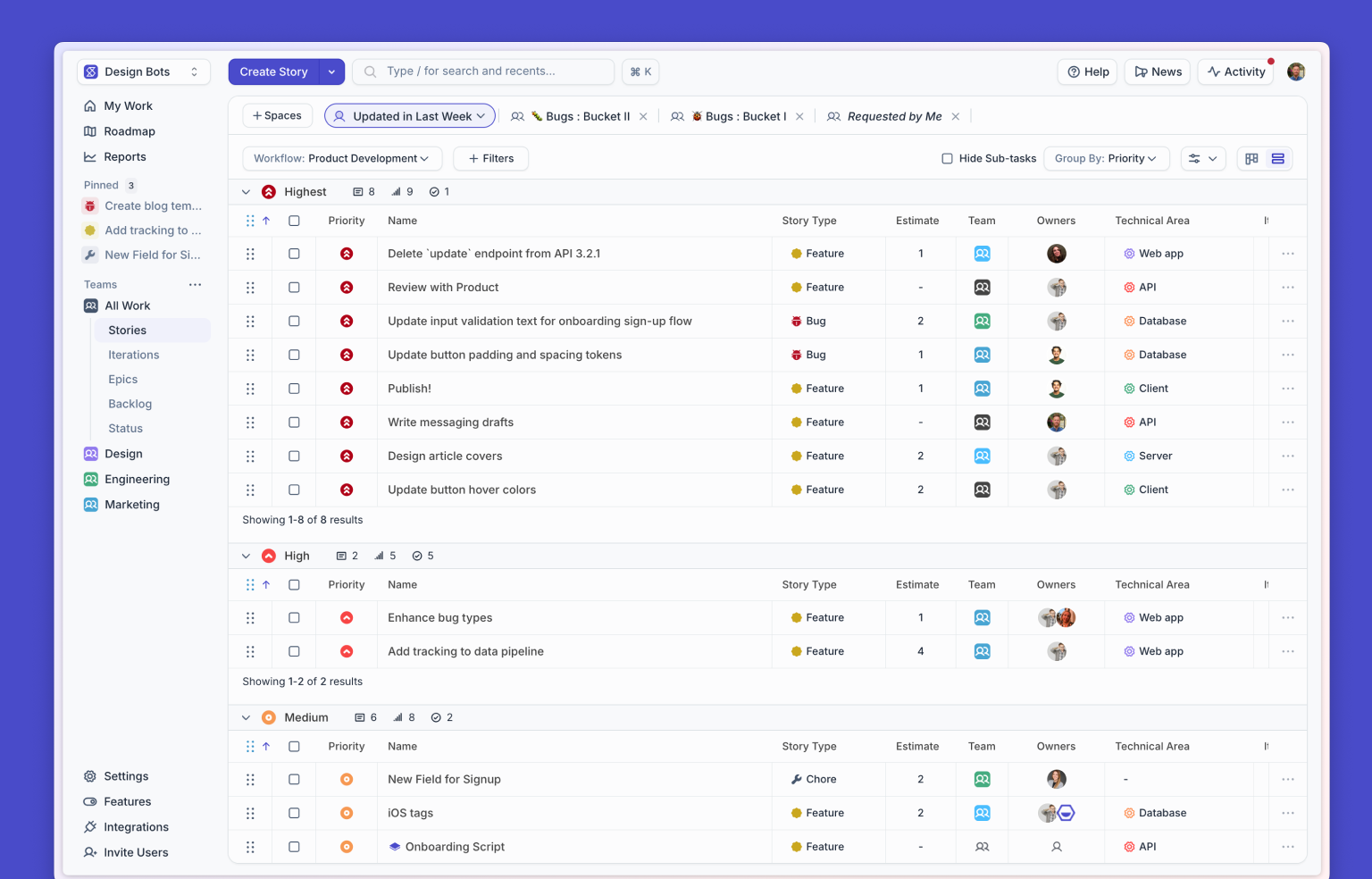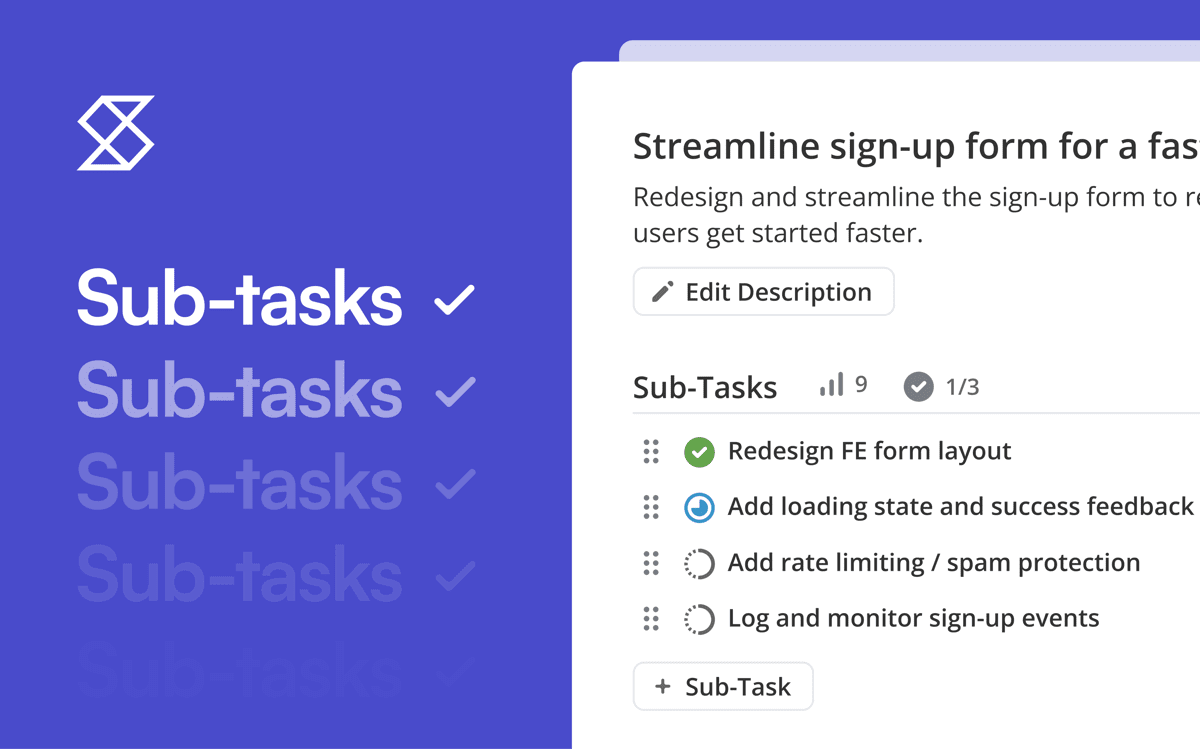When you discover something good, you want to share it with others. When you discover a project management tool that’s easy to use and makes getting work done enjoyable, you want to tell your team about it, and you want everyone to start using it.
How do you make this happen?
Maybe you already have a project management tool for your software team and are looking to switch. Or maybe you’re in the market for a new project management tool because you’re still using post-it notes and spreadsheets to manage your workflow.
Before joining the Shortcut team I was already a power-user. I have pitched Shortcut to a few previous teams and it ended up being our core workflow tool for product, engineering, and design.
Here’s how I championed Shortcut, in five easy steps:
- Sign-up for Shortcut’s free trial
- Consider your organization's key project workflows
- Set up Shortcut with your actual data
- Invite a few trusted team members
- Pitch it!
1. Sign up for Shortcut’s Free Trial
First, sign up for Shortcut’s free trial.
That was easy.
Now, consider your timeline. The longer you’re between two tools (or without one), the more your team is missing out on optimizing efficiency. We don’t want that. The faster you move to a new tool, the faster the team can become power users. We do want that.
We’ve seen people setup Shortcut in one day, get buy-in from their team and stakeholders, then purchase it the very next day. We have also seen teams take their time over the course of a couple weeks to acclimate users and import their data. This turnaround time will depend on your company culture, size, stage, and who’s holding the purse strings.
You have fourteen days to trial all of Shortcut’s features. Couldn’t quite get everyone in the room for the pitch within fourteen days? No problem, your account will still stay active on the Free plan for as long as you’d like after your trial.
2. Consider your organization’s key project workflows
Though organizations tend to follow fairly similar structures for their hierarchy or grouping of work, each organization is unique and faces different challenges. If you haven’t yet figured out the best way to organize your tracks of work, here’s a good place to start: Teams.
In Shortcut, a Team can represent a cross-functional squad, or any group of users who work on projects together; or, in Shortcut terms, users that collectively own Stories, Epics, and Iterations.
Teams are the central organizing force to help people in your organization collaborate and connect to other entities in Shortcut. Do you work within areas of the product (Onboarding, Payment, etc) or are focused on different supporting groups or KPIs (Performance, Growth, Retention, etc)? Later, you can add your pilot teammates to their specific Team. By setting up Shortcut around Teams, you have the ability to:
- Organize Users into Teams
- Assign Stories to Teams across Workflows
- Assign Epics to a Team
- Assign Iterations to a Team
- View a Team's Roadmap
- Quickly find work relevant to your Team
Milestones
A Milestone is a collection of Epics representing a larger initiative with a common goal.
Milestones are the highest level of organizational hierarchy and represent a large amount of work that could take a month or a quarter or longer to complete.
This structure breaks up work into smaller chunks (Stories & Epics) while giving a clear way to track progress toward large goals.
Epic
An Epic is a collection of Stories representing a larger body of work (like a feature).
Epics contain Stories from different Teams and Workflows, making them a great way for cross-functional teams to collaborate.
Story
A Story represents an individual piece of work. This work is to be completed in a Workflow and can be broken down with subtasks.
Stories are displayed kanban-style, and are organized by Workflow State. Customize your view on the left hand side of the Stories page.
Stories are the foundation of your work in Shortcut. You can even create your own templates to make Story creation custom to your organization.
Key Workflows
A Workflow is a set of States customized by your organization as the process through which Stories and Epics move from creation to completion.
Workflow States allow you to track progress toward work completion with the help of kanban boards. A Workflow can be customized specifically to fit each Team’s process.
There is a many-to-many relationship between Teams and Workflows, so a Team can have access to several Workflows and vice-versa.
Shortcut easily integrates with the engineering team process, but what about the remainder of the organization? Don’t forget about Product, Design, Data, Marketing, and so on. Make sure to account for how Shortcut will integrate into their workflows, and the overall R&D workflow at the organization.
And don’t forget about your support/experience team! They likely have a handful of tools they are already using to provide support to your customers and report issues, bugs, and feature requests. Make sure to account for how Shortcut will integrate into their workflow as well.
3. Setup Shortcut with Your Actual Data
Pick a few projects you’re currently working on, and go ahead and throw them into Shortcut. If you don’t currently have a project management tool, reference whatever you’re currently using to track work (spreadsheet? Notion doc? back of a napkin?) and create a few Milestones, Epics, and Stories based on the hierarchy you’re working within.
If you’re currently using another tool, like Trello or Jira, use our handy importers to move that work into Shortcut. Don’t worry about moving everything over just yet — you just want enough projects to show how it’s done when you try to get buy-in from teammates and demo the tool to stakeholders and decision makers.
A good move is to import work from the current quarter, so the Roadmap view will start to take shape.
4. Involve a few trusted teammates
Once you’ve considered your project workflow, accounted for how other departments will use Shortcut, and set up some real project data, you’re ready to begin championing. Buy-in from the team is critical - they will be the power users, after all.
Before opening the floodgates, invite a few teammates who are open to testing a new tool for their current work.
Do a quick 15-minute demo to walk through the key workflows and how you see the team using Shortcut. Collaborate with this group to setup the pitch, addressing their questions, concerns, and feedback.
5. Pitch it!
You’re ready to pitch Shortcut to key decision makers and make sure the person approving the budget is in the room. During this pitch, you’ll want to demo your organization’s key workflows with data from projects you’re actually working on.
Demo data is great (and Shortcut has a demo account accessible from your trial that you can utilize), but taking the step to import some of the real project data shows stakeholders familiar information that can show the value of a new tool.
Before presenting to broader stakeholders, make sure you:
- Setup your demo with real milestones, epics, and stories from your current workflows
- Evangelize and get buy-in from a few folks in teams across the organization (at least one person from each group who will use the tool in some capacity).
- Practice your pitch to your team, and work in their feedback
- Anticipate any questions stakeholders may have (and have answers for these!)
Start your free trial and begin telling your friends the good news.

















%20(788%20x%20492%20px)%20(1).png)
.png)

